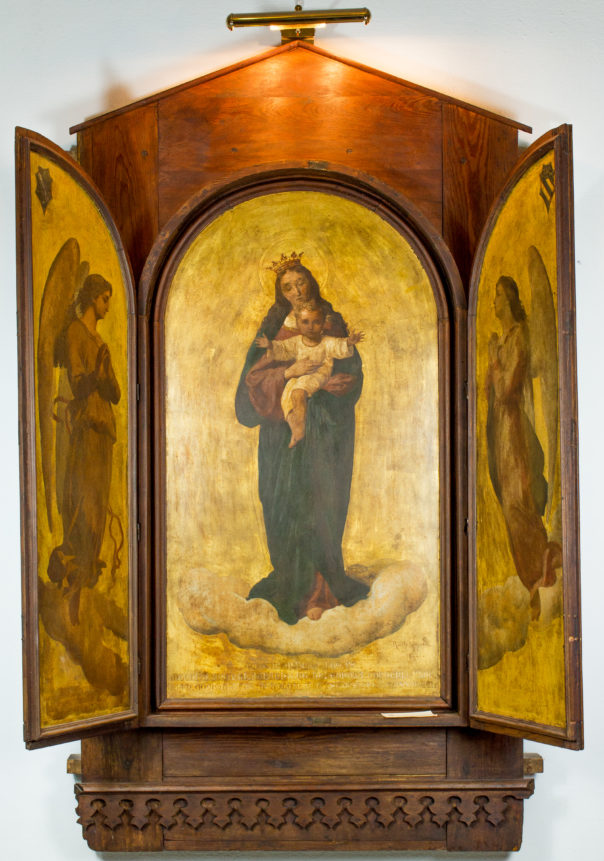
ITALIANO
(Scheda curata dalla prof.ssa Luisa Figari e dalla dott.ssa Alice Deledda)
TIPOLOGIA
Pala d’altare
TITOLO
Pala con Madonna e Bambino e angeli
AUTORE
Rodolfo Morgari
ANNO
1882
MISURE
05×185 cm (chiusa) – 130×185 cm (aperta)
MATERIE E TECNICHE
Dipinto ad olio su lastre metalliche in struttura lignea
COLLOCAZIONE
Sala Azzurra
NOTIZIE STORICO-CRITICHE
L’opera è un’ancona devozionale realizzata in scomparti con due ante che si chiudono sulla parte centrale, tramite cerniere e decori in ferro battuto sugli sportelli in legno, di ridotte dimensioni probabilmente per essere facilmente trasportata. La particolarità è la sua fattura: le figure sono realizzate con colori ad olio su lastre metalliche, tecnica impiegata soprattutto nel Cinque e Seicento, inserite in una struttura lignea centinata. Elementi che invece richiamano il medievalismo tipico della cultura storicistica dell’Ottocento sono l’uso della foglia oro per la realizzazione del fondo, l’immagine della Vergine col Bambino secondo la tradizione antica, le figure degli angeli danzanti, la scritta gotica dedicatoria. Il fondo oro indica la committenza aristocratica, come gli stemmi e l’iscrizione sul fondo: “EN TIBI MARIA VIRGO SS. AN. TONIUS JOSEPHI. HI MANNO ET HELEONORA. CORDERIA UXOR SUAM COMMITTUNT SOBOLEM TUO PATROCINIO TUTTISSIMAM A.D. DCCC LXXXII”.
L’opera è firmata e datata 1882. Il pittore, anche restauratore, lavorò sempre in Piemonte e la Pala fu acquistata dalla Fondazione a Torino nel 1999.
ENGLISH
(Notes by Art History professor Luisa Figari and Alice Deledda, BD in Cultural heritage)
TYPE
Altarpiece
TITLE
Altarpiece with the Madonna and child and angels
AUTHOR
Rodolfo Morgari
YEAR
1882
DIMENSIONS
05×185 cm (closed) – 130×185 cm (opened)
MEDIUM AND TECHNIQUES
Oil on metal sheets on a wooden structure
PLACING
Sala Azzurra (Light blue room)
HISTORICAL AND CRITICAL INFORMATIONS
The artwork is a devotional altarpiece made of compartment with two doors closing on the central part, with hinges and decorations in wrought iron on the wooden doors. The size is small, probably to allow it to be easily carried.
A distinctive trait can be found in its craftsmanship: the figures are made with oil paints on metal sheets, a technique especially used in the sixteenth and seventeenth centuries, inserted in a curved wooden structure.
The use of gold leaf to make the background, the image of the Virgin and Child painted according to the ancient tradition, the dancing angels figures , the Gothic dedicatory inscription are all elements that recall a medievalism typical of the nineteenth-century historicist culture.
The gold background indicates the aristocratic commission, such as the coats of arms and the inscription on the bottom: “EN TIBI MARIA VIRGO SS. AN. TONIUS JOSEPHI. HI MANNO ET HELEONORA. CORDERIA UXOR SUAM COMMITTUNT SOBOLEM TUO PATROCINIO TUTTISSIMAM A.D. DCCC LXXXII”.
The artwork is signed and dated 1882. The painter, which was also the renovator, always worked in Piedmont and the altarpiece was purchased by the Fondazione Siotto in Turin in 1999.
ESPAÑOL
(Ficha a cargo de la profesora Luisa Figari y de la lic. Alice Deledda)
TIPO
Retablo
TÍTULO
Retablo Virgen con niño y angeles
AUTOR
Rodolfo Morgari
FECHA
1882
DIMENSIÓN
05×185 cm (cerrato) – 130×185 cm (abierto)
MATERIALES Y TÉCNICAS
Pintura a óleo sobre chapas metálicas y estructura de madera
UBICACIÓN
Sala Azul
NOTICIAS HISTORICAS
La obra es un retablo devocional realizado en compartimientos con dos hojas en la parte central, a través de bisagras y decoraciones en hierro forjado en las hojas de madera, de pequeñas dimensiones probablemente para poderlo transportar con facilidad.
La particularidad es su factura: las figuras realizadas con colores a óleo sobre chapas metálicas, técnica utilizada sobre todo en el siglo XVI y XVII, insertadas en una estructura de madera curva. Elementos que recuerdan al medievalismo típico de la cultura del historicismo del siglo XIX son el uso de la hoja de oro para la realización del fondo, la imagen de la Virgen con el Niño según la tradición antigua, las figuras de los ángeles danzantes, la inscripción gótica dedicatoria. El fondo oro indica que el pedido fue por parte de aristocráticos, como los blasones y la inscripción en el fondo: “EN TIBI MARIA VIRGO SS. AN. TONIUS JOSEPHI. HI MANNO ET HELEONORA. CORDERIA UXOR SUAM COMMITTUNT SOBOLEM TUO PATROCINIO TUTTISSIMAM A.D. DCCC LXXXII”.
La obra lleva firma y fecha 1882. El pintor, y restaurador también, trabajó siempre en Piemonte y el retablo fue adquirido por la Fundación en Turín en 1999.
